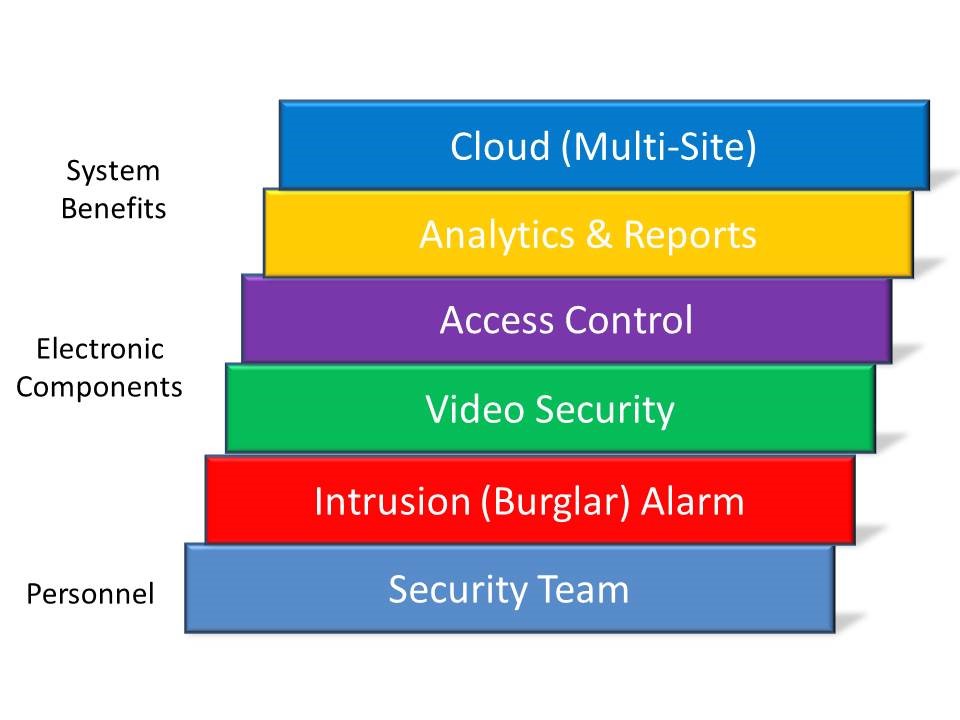
Layered Security Approach for Churches
Published in INSIGHT - Spring 2019
Keith Shaver
 The security industry is receiving an increasing number of requests for various types of security solutions from churches. National news outlets are reporting an ever-increasing number of church vandalism, theft, robberies, and in some instances active shooters on or within church campuses. Those reports along with a greater interest for safety concerns across the nation are driving the local church to investigate methods to better secure the church facility and protect its member’s personal security while attending activities.
The security industry is receiving an increasing number of requests for various types of security solutions from churches. National news outlets are reporting an ever-increasing number of church vandalism, theft, robberies, and in some instances active shooters on or within church campuses. Those reports along with a greater interest for safety concerns across the nation are driving the local church to investigate methods to better secure the church facility and protect its member’s personal security while attending activities.
For the church to provide the right security solution it is recommended the church review its current security plans and procedures. Two key elements to consider during this review are a security team and the use of electronic security equipment options. The security team is the most cost effective security measure. This team can provide the eyes and ears to monitor activities in the parking lot, facility entrances, worship venues and classroom hallways. The security team is an important piece of the total security objective, but without 24-hour surveillance the church will be unable to ensure security after normal attendance hours. To provide around the clock surveillance, the church will need to investigate electronic security options. Keep in mind you may want to start with one solution and grow the electronic security capabilities as budget and resources allow. So which option is implemented first?
To understand the electronic security options and decide which option should be selected first let us look at a layered approach to security. The layered approach allows you to step-in at any level, even with an existing system, by simply upgrading the system’s capabilities. Let us assume for this discussion you are just beginning to think about the security options and are starting at ground zero without a security team and with no electronic systems currently installed in your facility.
Review Current Situation
To start the review of the current situation, investigate the immediate personal security needs of staff and church members and review any past security incidents. Have there been any issues with vandalism, theft, personal or facility robberies, accidents inside or outside the facilities, domestic or personal conflicts, mental illness issues, arson, or worst case - a shooting? Are cameras in use and properly located or do you need to relocate to change the view? Does your staff arrive early or work late causing a concern for personal safety? Are there any existing facility use issues with members or your community outreach in the use of keys? Have you received any children and nursery monitoring questions from parents? Do you have issues with unauthorized visitors from past incidents or persons with a criminal intention?
Finally, determine if the church has existing security components. If so they should be reviewed for potential upgrade or consolidation into an integrated security system. The consolidation will allow you to manage the system with only one user login and offers simplified operation.
Future Needs
After reviewing the current situation, it is time to plan for the future. Is the church considering any new buildings or campus growth that will exceed your current security infrastructure? How does the future impact the security team? Are additional cameras required? Can you identify any projected future needs such as perimeter door access, restricted interior door access for children, nursery, A/V and computer equipment or server rooms? If you make available meeting space for your community after-hours, do you need to provide new access into the buildings? Does your church include off-site or remote buildings or worship venues which may require multi-site security?
Given the concerns listed, current situation and future needs, let us review the layered approach to define the various security layers in detail and to identify possible solutions.

Security Team
The base of any security solution is a security team. The team can be a mix of interested lay persons, but also should include a mix of active or retired law enforcement persons. Oftentimes churches employ a local police officer who is on site for each service along with a police cruiser. This is typically an affordable option even for small churches. The security team members must be dedicated and willing to be scheduled for church services and events. The team members should communicate with and rely on the local police agencies for ultimate authority of force if needed at the facility. Many times the local agencies will provide training for your team and there are several security and safety consultants who can assist in creating a team and defining the necessary internal church procedures.
Intrusion Alarm
The first electronic layer is an intrusion alarm also known as a burglar alarm. This system is similar to a system installed in a home with keypads, door and window contacts but also includes specialty sensors such as glass break sensors, advanced motion detectors and panic alarm buttons. This system provides a level of security and peace of mind similar to the home alarm system for those arriving early or working late, and provides after-hours security by notifying law enforcement of unauthorized access or entry attempts to the building. There are several national and regional licensed commercial integrators who can address the church facilities. The alarm systems typically include an application that enables you to control (arm/disarm) the system from a mobile phone or tablet device.
Video Security
The second electronic layer recommended is a video security system – either a basic or advanced integrated system depending on the quantity of cameras and system design requirements. The video system is the best option for personal identification of persons on the church campus or inside the buildings, and provides documentation and evidence for law enforcement of the events connected with vandalism, theft, accidents and child and nursery safety. The basic system could be from one to sixteen cameras and a mixture of interior or external camera models depending on individual building needs. The cameras are recorded on a network video recorder (NVR) which also provides remote connection for a mobile phone or tablet. The recorder can be programmed for time-lapsed recording or motion triggered recording which extends the length of recording time.
The advanced integrated system can control and record hundreds to thousands of cameras thereby expanding the basic system capabilities, use of the facility’s existing cameras, or provide a new security solution while offering a comprehensive level of features and capabilities. The internet protocol or IP cameras are recommended which provide excellent video image clarity. It is recommended a commercial security integrator be employed to install the video security system to ensure the church is protected and building code compliant. In both the basic and advanced integrated systems; the cameras ensure video images of possible illegal activities, outdoor incidents or accidents, and unauthorized attempts to gain entry to facilities are recorded and viewed remotely if needed. In addition, the cameras allow documentation of activities in children’s classrooms to alleviate parent and church safety concerns.
Access Control
The third electronic layer is access control. Access control represents the largest infrastructure investment in an existing building but this is typically not an issue with new construction. The access control layer consists of electronic lock hardware on the external doors, and in many cases some interior doors, providing perimeter and interior security. The doors may be unlocked by an authorized person swiping a plastic access card or key-fob near a card-reader device mounted near the door. The act of swiping a card or key-fob can be integrated with the burglar alarm system to arm or disarm the system and can be linked with the video system to begin recording. The access control system can be managed by mobile phones or tablets which prevents the need for staff to be present to let people in or to secure the facility after hours. One additional benefit of access control is the elimination of key-management issues such as who has a key, how many duplicate keys exist, if unauthorized keys have been made or how many keys have been lost?
Integrated System Solution with Analytics
The intrusion, video and access control solutions work as individual pieces of a security system as described above, but do not offer consolidated system operation since the two to three individual pieces may not be integrated to work together. There are systems offering a fully integrated solution which enables event linkages and sharing of information to trigger actions such as alarm, recording quality, locking of doors or to interact with persons in the building. Along with the video monitoring of the cameras, the integrated system’s features include perimeter and interior door access control, intrusion alarm system management and analytics. These analytics can include various audio analytics such as car alarm, glass break detection, aggressive speech, and gunshot detection. Various motion analytics are possible with people count/direction, loitering, object moved/taken, as well as higher level analytics such as facial recognition and license plate capture/recognition. The integrated access control provides video documentation of unauthorized attempts to gain access to the facility or into restricted areas which may then be turned over to law enforcement. Integration with the intrusion alarm system allows for a coordinated link between the video and access control for central management and reporting of activities.
Cloud
The cloud is a term used to describe “internet storage”. The cloud is a vendor hosted location over the internet which allows customers to store files. In the case of an integrated solution described above, the cloud would contain an automatic backup of the system which can be accessed to download or update the individual integrated system. The cloud does not hold video images – those remain on your local system. Rather it contains the configuration files, programming data, enables multi-site viewing and allows system-wide programming if you have multiple locations each with an integrated system. The cloud represents an easy way to gain access to all your systems and completes the unique security solution by integrating video management, access control, intrusion, video analytics and managed services into a single IP security appliance.
Summary
Church security is no longer a luxury – rather it is a requirement to help ensure the safety and security of the church and its members. Security may be a single person patrolling the parking lot, or a team of individuals walking the grounds during services. It may include a basic alarm system, a video security system, a discrete electronic access control system or a fully integrated security system with analytics and reporting -- but it is at some level – a requirement. The layered approach allows the church to look at the current situation, address the needs and if necessary begin small and over time grow the system potential with features that support the increasing security requirements.
Uniview Technology (uniview tec) is a new alternative to the current off-shore video security products with a focus on houses of worship. Based in north Texas, Uniview Technology is a Texas registered company with U.S. based operations. The operations include sales and design assistance across the US to help design a video system for your church with local customer support and technical service.
Keith Shaver
Uniview Technology – uniview tec
keiths@univiewsales.com
(972) 459-8609